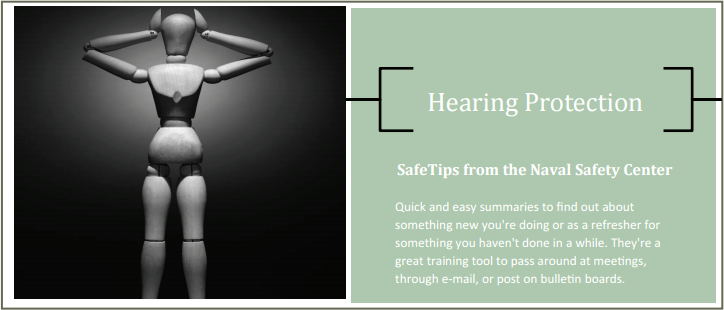Hearing Conservation - Safety
Process for scheduling an Occupational Health or Audiogram Appointments
for Monterey OH-HCP Enrollees
- Employee supervisor:
- Complete the SECNAV 5100/1 form.
- Contact the Occupational Health (OH) Clinic to make an appointment.
- Provide the completed SECNAV 5100/1 to the OH Clinic (via secure email) when scheduling.
- Once scheduled, the OH clinic will provide the Medical Matrix paperwork to the supervisor. The employee must fill out this paperwork and bring with them to the appointment.
- To schedule an appointment, follow the below process (in the listed order) and continue to move down the list until you have success:
- Call 831-242-5332 (OH Technician) – This position is currently vacant. Don’t leave a voicemail. Call the OH Nurse below if no one answers this phone line.
- Call 831-242-4842 (OH Nurse).
- Email Ms. Flora Dela Pena (OH Nurse) at: flora.a.delapena2.civ@health.mil and Dr. Johnson (Occ Med Doc) at: edward.g.johnson30.civ@health.mil.
- Email safety@nps.edu we will engage with POCs (OH Nurse & Occ Med Doc).
- If no success with the above scheduling process, contact the below POCs in this order:
- Lemoore Occupational Health Nurse (LT Comia) at: 559-998-0558, ernest.a.comia.mil@health.mil and Lemoore Occupational Medicine Physician (LCDR Montoya) at: miguel.a.montoyavillagomez.mil@health.mil or 559-998-0558.
- OIC of Naval Medical Admin Unit (NMAU) Monterey, LCDR Josh Corbridge, at: joshua.d.corbridge.mil@health.mil or (831) 656 3487.
- Regional Occupational Health Nurse, Ms. Jeanne Bridger, (for Occ Health exams) at: jeanne.c.bridger.civ@health.mil or 619-767-6608.
- Dr. Kelly Paul (for audiograms) at kelly.s.paul.civ@health.mil or 619-767-6578.
Hearing Conservation Program
The goal of the Navy hearing conservation program is to prevent occupational hearing loss and ensure auditory fitness for duty in the military and civilian workforce. The program includes the following:
Noise Measure and Analysis - Survey work environments to identify potentially hazardous noise levels and personnel at risk.
Engineering Control - Reduction of noise at the source. Environments that contain or equipment that produces potentially hazardous noise will, whenever it is technologically and economically feasible, be modified to reduce the noise level to acceptable levels.
Hearing Protective Devices - The use of personal hearing protective devices to limit noise exposure should only be an interim protective measure while implementing engineering controls. Where engineering controls are not feasible, administrative controls and/or the use of hearing protective devices shall be employed.
Audiometry - Periodic hearing tests monitor the effectiveness of the hearing conservation program. Early detection of temporary threshold shifts allows further protective action to be taken before permanent hearing loss occurs. Necessary follow-up evaluation will be conducted to ensure appropriate referral, treatment and early return to duty.
Education - Individuals exposed to hazardous noise, their supervisors, and people providing hearing conservation services (i.e., training, monitoring, hearing protection, etc.) will receive training.
Training these individuals is vital to the overall success of a hearing conservation program.
1) An understanding of the permanent nature of noise-induced hearing loss
2) Its negative effects on operational readiness and individual fitness for duty
3) The command's hearing conservation program
4) The individual's responsibilities under the program are all essential for program effectiveness.
Also, regions and activities shall encourage all Navy employees to use hearing protective devices when exposed to hazardous noise during off-duty activities, e.g., from lawn mowers, chain saws, firearms, etc.
Federal OSHA standard
29 CFR 1910 Subpart G - Occupational Noise Exposure (1910.95)
-
Programs
- Laser Safety Program
- Acquisitions Safety
- AED
- Asbestos
- Emergency Management
- Environmental
- Ergonomics
- Fall Protection
- Hearing Conservation
- Industrial Hygiene
- Lead (Pb)
- Lithium Batteries
- Medical Surveillance
- Motorcycle Safety
- Occupational Health
- Operational Risk Management (ORM)
- Recreational Off Duty Safety (RODS)
- Reproductive Hazards
- Respiratory Protection
- Weight Handling
- Lab Safety


